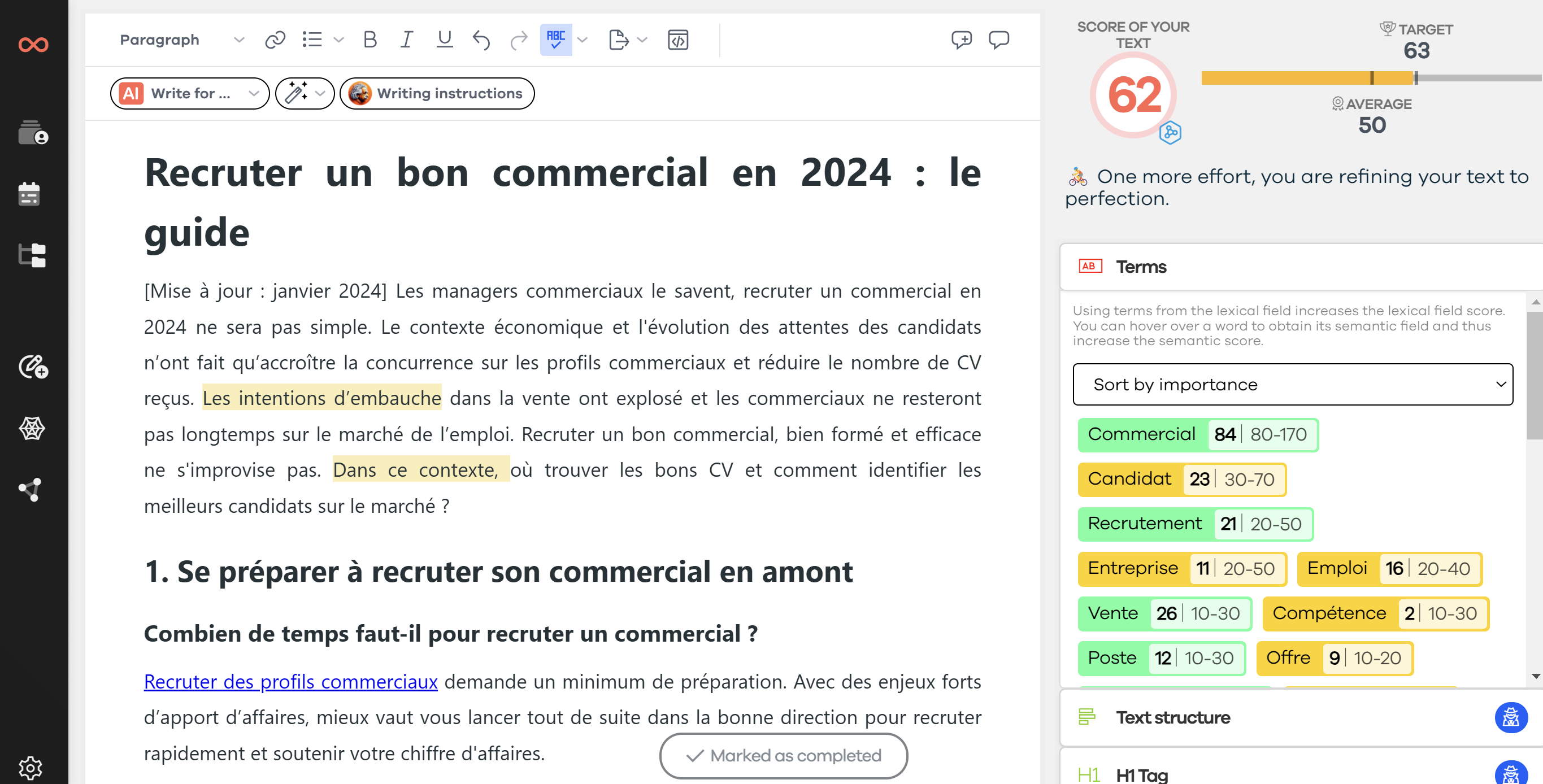Would you like to discover how to analyze the optimization of content published on your blog or that of your client? I invite you to discover my approach. The SEO article example chosen is a blog post recently published on our site. I dissect and check all the fundamental elements to promote its organic ranking.
🚀 Quick read: the main points of the SEO article example
Do you want to immediately get an overview of the level of expertise you will find in this article? Here is the summary of the 10 points we will check in this blog post!
- Keywords: relevance and potential for organic traffic.
- Keyword clustering: correspondence with the blog's area of expertise.
- Lexical and semantic field: development of the subject.
- Search Intent: meeting the needs of Internet users.
- Web writing rules: adaptation to digital reading and SEO criteria.
- Metadata: providing relevant information on Google's results pages.
- Media: offering additional information and relaxing the reader's attention.
- Internal linking: allowing visitors and search engines to browse the site.
- External links: adding value to the proposed content.
- Promotion: making the article known before it is indexed.
🔎 SEO article example: the 10 optimization factors
I invite you to look together if the optimization of my latest blog post is satisfactory. The SEO article example is this content published last week: https://www.seoquantum.com/billet/ecrire-article-seo. It's a good thing, as it deals precisely with this subject! I propose to see if I am a good student and if I have respected the SEO rules.
1. Key query and variants
In this SEO article example, the key query is "write an SEO article." The choice of the keyword corresponds to the theme of the SEOQuantum blog and meets the expectations of our target readership. Its search volume is not huge (about ten per month), but it includes a large number of related keywords.

As a secondary query, we decided to work on "how to write a referencing article" (less than ten monthly searches!). However, by working on these two queries, we hope to position this page on a whole set of keywords:
- write an optimized SEO article;
- how to write an SEO blog article;
- how to write a good SEO article;
- blog article referencing;
- optimize article referencing;
- blog article referencing;
- etc.
As a result, this content has good potential to appear on Google's results pages for at least twenty different queries. In total, these keywords represent more than a hundred searches per month on the search engine. Its SEO potential is therefore satisfactory!
2. Keyword clustering
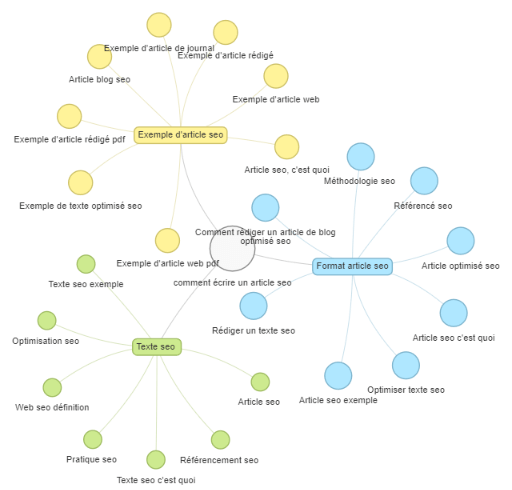
On the blog, we have already published numerous articles on SEO content and web writing. As a result, this new topic is entirely relevant to our content strategy and our implementation of keyword clustering.
By doing so, we want to meet the needs of our readers while demonstrating to search engines our level of expertise in this field. Thus, not only can this content directly attract organic traffic, but it also helps to strengthen the relevance of associated articles.
However, the SEOQuantum tool indicates that it is still possible to improve the thematic relevance of the site. Moreover, you will notice that the theme of the day ("SEO article example") is part of the list of suggestions from the tool. In addition, we still have a few other topics dealing with this theme that we are looking forward to sharing with you.
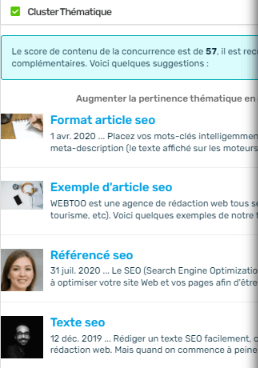
3. Lexical and semantic field
To ensure that the indexing robots understand that the theme has been well covered, the lexical field of the example has been carefully considered. This also allows the copywriter to build an editorial plan that covers the entire subject. Moreover, it pleases the reader who does not continuously read the same keyword from the beginning to the end of the blog article.

However, I notice that the semantic field of the SEO article example could be improved. Indeed, its score is slightly lower than the competition. To perfect this element, it would be interesting to analyze our SEO competition to better understand how they developed the subject and thus be inspired to optimize the article.

4. Search Intent
What is the user's intent when searching for the subject of our SEO article example on Google? To find out, just go to the search engine!
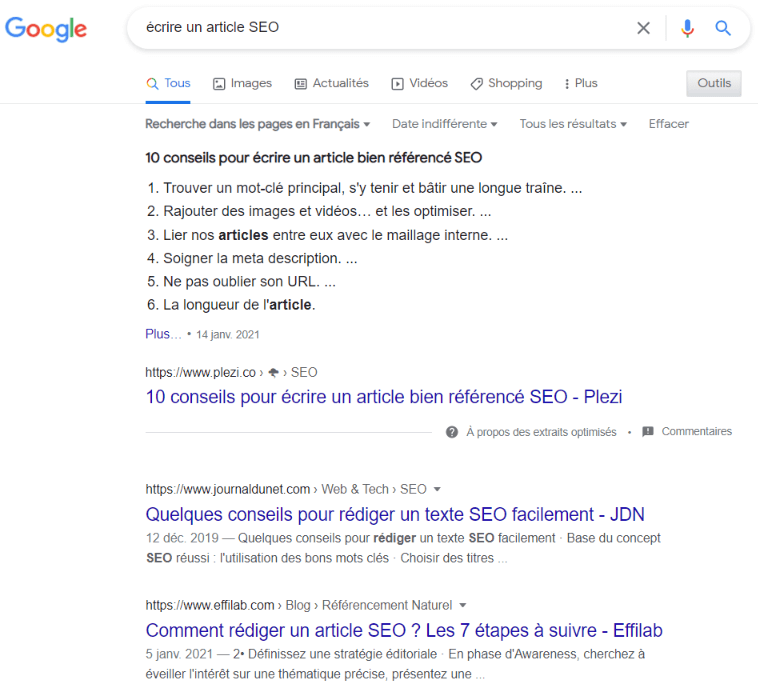
These are just the first three results displayed. However, the trend is clear: it is an informational query! The optimized article must then respond to this demand by providing a large amount of information. In this case, it will allow the reader to manage on their own to write the content of their blog.
Moreover, since we offer content that matches the search intent, we also meet Google's needs. If we had written a commercial or transactional text, the search engine might tend to ignore our blog post, as it would certainly not interest its user.
5. Web writing rules
There are far too many web writing rules for us to analyze them all here. That's why I suggest we focus only on the most important elements for the article's ranking.
- How to succeed in high-quality web writing?
- Web copywriter job description: training, role, evolution, salary
- Web copywriter: what are the online training courses?
5.1 Readability
As this is not a technical article aimed at natural referencing experts, the text must be easy to read. Sentences should be short, the text airy, and the vocabulary understandable for everyone. The use of bold words also allows for simplified reading while highlighting information to search engines.
To capture your reader's interest, an important web writing rule is to quickly respond to the query intent. This is the case in our SEO article example from the first subtitle. Accompanied by an infographic, this paragraph allows the visitor to immediately get an answer and know if the reading meets their needs.

Furthermore, the SEOQuantum tool shows that the readability of this blog post is good. It is even higher than that of the first results proposed by Google, which is a significant SEO advantage. However, I notice that 36% of the sentences are more than 20 words long, which could be reduced to 25% to further improve the digital reading of this content.

5.2 Hot zones
By "hot zone," we mean the text locations that have the most influence on organic ranking. The title of the article (H1) and the subtitles (H2, H3, etc.) are part of these places where you should add your key query and its equivalents. In our SEO article example, the main keyword is present in the main title and in two H2s.
A synonym of the key query is also present in another H2. As a result, three of the five H2 subtitles are well optimized, which is a good performance. On the other hand, none of the twelve H3s are optimized. However, this is a deliberate choice, as the reader has been favored over the indexing robots!
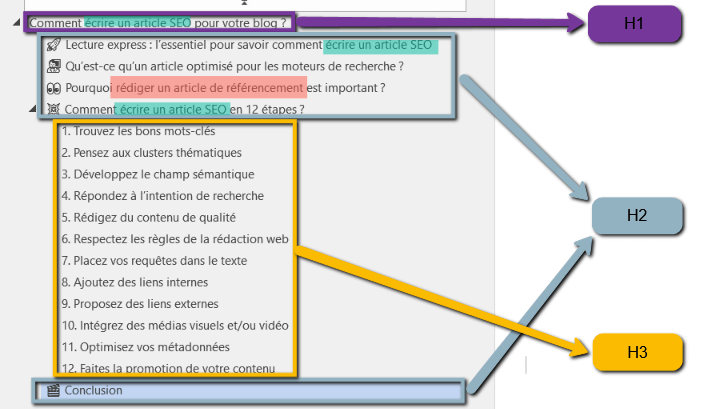
5.3 Introduction
The introduction is a place where you should pay the utmost attention. Indeed, this short paragraph is the trigger for your reader. Either it seems relevant to them, and they will continue reading, or they will look elsewhere. Therefore, Google seems to give a lot of value to the first hundred words of content.

In our example, you can see that the key query appears in the lead of the article. It is accompanied by several terms from the lexical field, and the important words are in bold. It describes a problem, a solution, and an overview of the upcoming content. I therefore think that this element is well optimized for referencing.
5.4 Text length
There is no magic length that will make your SEO article favored by search engines. Each decision must be made on a case-by-case basis with the primary objective of covering the subject in its entirety. In a second step, it is then interesting to compare the length of your SEO content with the competition.

Our article contains 2,228 words, which is already quite long. I think I have not forgotten any crucial points and therefore have said enough on the subject. We also note that the average content length for this theme is 2,220 words. To stand out and take a little margin, I could have added another H2 that deals with mistakes not to make.
6. Metadata
The title tag is 56 characters long, allowing for a complete display in the SERP. I chose to use an equivalent of the key query, which broadens the level of information transmitted to Google. Moreover, depending on the query formulation, the search engine does not hesitate to display the H1 (or even an H2) to display the result that seems most suitable to it.
The meta-description contains 179 characters, which is a bit too long to be fully displayed on Google. However, all the information is present in the description, and only the end will be truncated, leaving the text understandable. And, once again, another part of the content could be presented if it is more relevant to search engines.
7. Media
A large number of multimedia files are present in our optimized SEO article example, which adds value for Internet users and promotes SEO.
- Three infographics that allow visualizing the concepts explained.
- Two screenshots that illustrate the statements.
- An illustration image that conveys a message corresponding to the subject.
- A video to rest the reading and give the floor to a recognized expert.
The "alt" attribute of visual media has been well informed, which facilitates the understanding of visually impaired people and search engines. The main query or its equivalents are also present, which is favorable for SEO. As a result, I believe that optimization is correct at this level.
8. Internal linking
22 internal links are present in the article taken as an example. Each is relevant to the subject discussed and naturally integrates into the content. This is a high number of hyperlinks, which could bring only little "link juice" to the targeted pages.
However, the integration of internal linking done this way allows for condensing information and answering Internet users' questions more simply. Thus, even if the optimization is not perfect, the reading comfort is ensured.
9. Outbound links
Three external links have been integrated into the analyzed article. They each point to authority websites (Wikipedia, Twitter, and Google) and are definitely not present for commercial reasons. This is therefore a positive point for improving referencing.
Two of the links provide complementary information to the content section concerned. The third serves to justify the authority of the cited source. As a result, these outbound links are legitimate and meet Google's criteria.
10. Promotion
To make the article known to a qualified readership and attract traffic, it has been relayed on several communication channels.
- Social networks: a tweet allowed sharing the blog post URL.
- Newsletter: an email was sent to inform our regular readers of the publication of new content on the site.
- Specialized site: a short article containing the link to our page was published on a site specializing in natural referencing.
Although other channels could have been used (especially LinkedIn), the article was effectively promoted. Thus, even before Google indexed the page, it received visits. I therefore think that the minimum has been done at this level.
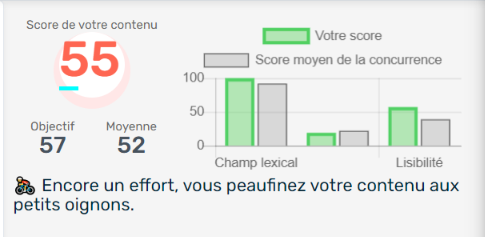
As you can see, the referencing article taken as an example is not optimized at 100%. Indeed, some elements could be improved to make it optimal.
- Write more content on related topics;
- use more expressions from the semantic field;
- add the key query to several subtitles;
- reduce the length of sentences;
- lengthen the text;
- shorten the meta-description;
- reduce internal linking;
- increase promotion.
However, most of these referencing factors have been neglected to favor reading comfort and user experience. That's why, in the end, I am quite satisfied with the SEO score obtained! We will then see the results we will get in the coming months and the feedback you will give us.
And you, how did you optimize your SEO articles? Do you always strive for perfection, even if it means favoring search engines?
Need to go further?
If you need to delve deeper into the topic, the editorial team recommends the following 5 contents:

